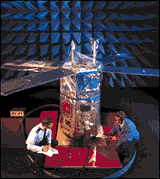APEX
Advanced Photovoltaic Experiment
 APEX successfully tested a wide array of advanced photovoltaic and electronic components in a harsh radiation environment, provided significant data to support improved designs for future space systems. During operation, APEX's highly elliptical orbit allowed the investigation of space plasma effects on high-voltage operation (current leakage at positive voltages and arcing at negative voltages) in the perigee region, plus the investigation of space radiation effects (decreased array power output from passage through the inner radiation belt) in the apogee region.
APEX successfully tested a wide array of advanced photovoltaic and electronic components in a harsh radiation environment, provided significant data to support improved designs for future space systems. During operation, APEX's highly elliptical orbit allowed the investigation of space plasma effects on high-voltage operation (current leakage at positive voltages and arcing at negative voltages) in the perigee region, plus the investigation of space radiation effects (decreased array power output from passage through the inner radiation belt) in the apogee region.
Spacecraft
Based on Orbital Sciences' PegaStar bus which integrates the booster upper stage avionics and spacecraft bus functions. PegaStar can support payloads from 50 to 150 kg and provide up to a 10-year mission life. A modular design supports a wide range of stabilization and pointing requirements. Orbit average power available to the payload is approximately 100W to 200W, depending upon the mission orbit.
Payload
The PASP (Photovoltaic Array Space Power) Plus experiment conducted test on advanced photovoltaic technologies under carefully controlled conditions in order to compare and evaluate the different ways in which solar cell performace is degraded by the space environment. The operation of solar arrays at higher than the standard voltage level (28 volts) can result in much more efficient power production. PASP Plus was able to bias the arrays to both high positive and negative voltages (as high as 500 volts) in order to study how much the voltages could be increased before arcing and sparking occurred. Tweleve types of arrays were tested including four silicon-based planar arrays, three gallium-arsenide on germanium planar arrays, three new-material (indium-phosphide and two other multi-bandgap) planar arrays, and two concentrator designs.
APEX also hosted the Cosmic Ray Upset Experiment (CRUX), sponsored by NASA's Goddard Space Flight Center; and the Thin-Film Ferroelectric Experiment (FERRO), developed by the Naval Postgraduate School.
| Country of Origin | United States |
| Customer/User | U.S. Air Force |
| Manufacturer(s) | Orbital Sciences |
| Orbit | 363 km x 2550 km, 70 deg. inclination |
| Related Sites | Orbital Sciences' PegaStar PSAP Report |
Launch Facts
| Name | Int'l Desig. | Date | Site | Vehicle | Orbit | Mass(kg) |
| Notes | ||||||
| APEX | 1994-046A | 8/3/94 | WSMC | Pegasus | LEO | 260 |
| Advanced Photovoltaic and Electronic Experiments; studied radiation and plasma effects on solar power systems | ||||||
Information in The Mission and Spacecraft Library is provided without warranty or guarantee. USE AT YOUR OWN RISK.